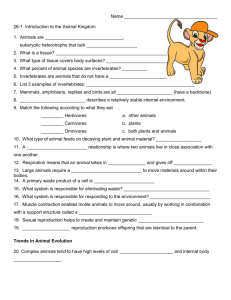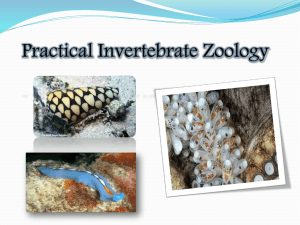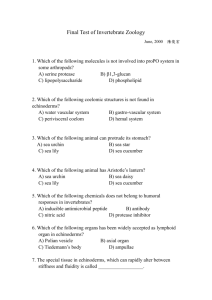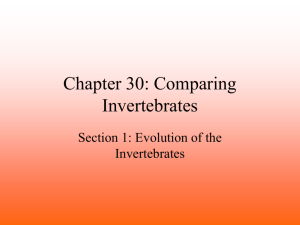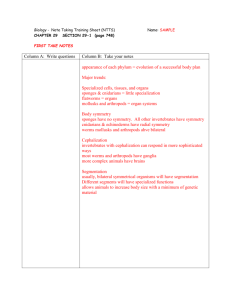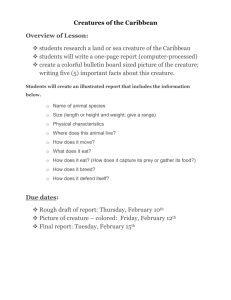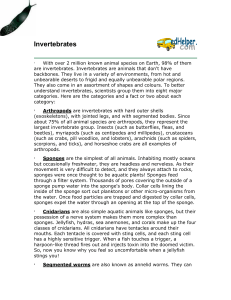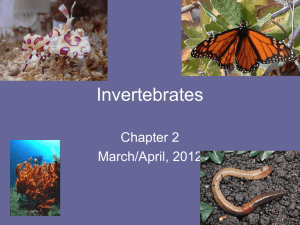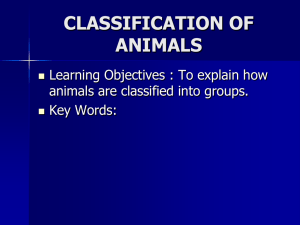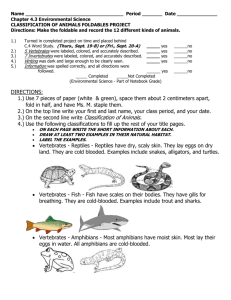29.2 notes
advertisement
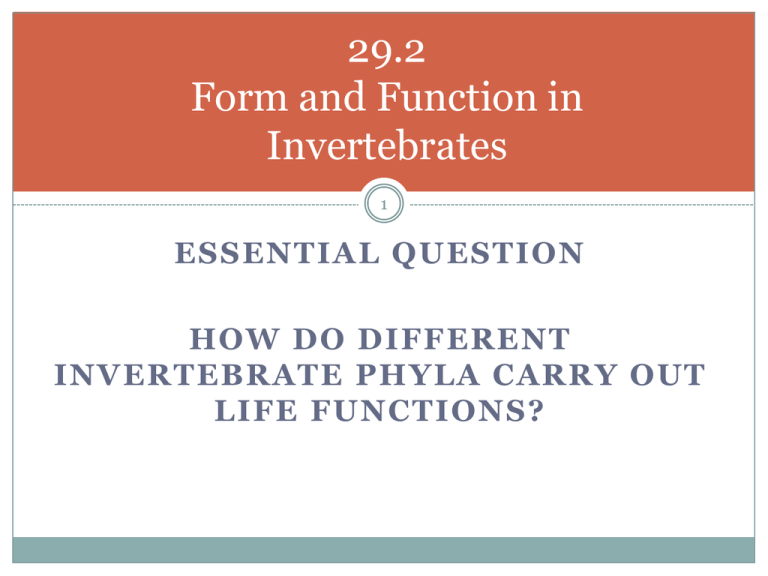
29.2 Form and Function in Invertebrates 1 ESSENTIAL QUESTION HOW DO DIFFERENT INVERTEBRATE PHYLA CARRY OUT LIFE FUNCTIONS? Feeding and Digestion 2 Simplest animals digest food by intracellular digestion food digested inside cells Sponges ingest food in archaeocytes which pass into other cells by diffusion More complex invertebrates use extracellular digestion food broken down outside cells in a digestive cavity or tract and then absorbed into the body Mollusks, annelids, arthropods, echinoderms Flatworms and cnidarians use both processes Patterns of Extracellular Digestion 3 Simplest animals such as cnidarians and flatworms ingest and expel food through a single opening Digested food then diffuses to cell throughout body More complex animals digest food in a tube called a digestive tract One-way digestive tract is characteristic of roundworms, annelids, mollusks, arthropods, and echinoderms Food enters through mouth and waste leave through anus Specialization allows animals to process food more efficiently Respiration 4 Respiratory organs have large surface area that are in contact with air or water. Surfaces must be moist so diffusion to occur More surface exposed to environment = greater amount of gas exchange that can occur Cnidarians and flatworms use diffusion Aquatic invertebrates like mollusks use gills that bring blood closer to surface for gas exchange 5 Terrestrial invertebrates Snails have surfaces covered by mucous membranes which reduces water loss Spiders have book lungs Insects have tracheal tubes and air enters through spiracles Circulation 6 Open circulatory system blood is partially contained within a system of blood vessels Blood comes into direct contact with tissues and is pumped into system of sinuses that makes its way back to the heart Found in most mollusks (except octopus) and arthropods Closed circulatory system Heart or heart-like organ forces blood through blood vessels Blood stays in vessels and diffuses into tissues More efficient than open system Characteristic of larger more active animals Found in annelids and some mollusks (octopus) Excretion 7 Animals must get rid of a byproduct of cellular respiration – ammonia Must also have way to control the amount of water in tissues Aquatic invertebrates – ammonia diffuses from body tissues into surrounding water Flatworms use a system of flame cells to eliminate excess water 8 Terrestrial invertebrates must conserve water while removing wastes Animals convert ammonia into urea and is eliminated as urine Some insects and arachnids use Malpighian tubules to capture ammonia and excrete it as uric acid Three trends in evolution of nervous system 9 Centralization – nerve nets consist of nerve cells that form a net-like arrangement throughout the body Flatworms have ganglia in their head Cephalopods have ganglia organized into a brain that coordinates the nervous system Cephalization – concentration of nervous tissue and organs in one end of the body Specialization – the more complex animals the more developed sense organs Flatworms have simple eyespots Insects have compound eyes Movement and Support 10 Invertebrates have one of three kinds of skeletal systems hydrostatic skeletons – skeleton based on a fluid-filled body that supports the muscles; worms Exoskeletons – external skeleton made of chitin which supports muscles; arthropods Endoskeletons- structural support inside of body made of calcified plates; echinoderms Sexual Reproduction 11 Most invertebrates reproduce sexually during at least one part of their life cycle. Sexual reproduction maintains genetic diversity by allowing for new combinations of genes Meiosis - fusion of haploid gametes during fertilization to form diploid zygote Zygote undergoes mitosis and develops into animal by differentiation Most invertebrates have separate sexes. Some animals like the flatworm are hermaphrodites Asexual Reproduction 12 Zygote divides by mitosis after fertilization to grow into multicellular individuals. Offspring are identical to adults Involves diploid cells allows animals to increase its numbers rapidly Exact copy of original cell Includes budding and mitosis (division in two) Internal and External Fertilization 13 External – eggs are fertilized outside of females body Internal – eggs are fertilized inside of females body
